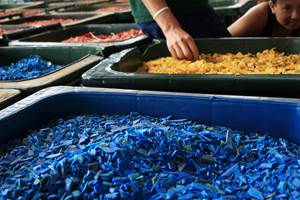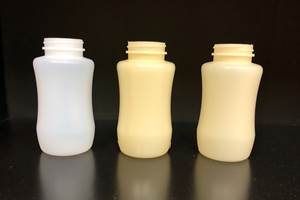Bioplastic Based on a Fragrant Cellulose By-Product
U.K. university researchers utilize chemical found in pine needles to produce new bioplastic.
U.K. university researchers utilize chemical found in pine needles to produce new bioplastic.
Last month, I blogged about strides being made in the development of novel biodegradable plastics, including one derived from the organic compound chitin extracted from shrimp shells and one based on the cassava root—both of which are targeted to the production of shopping bags, food packaging and other flexible film applications.
Strides are also being made in the development of renewably-sourced, tougher engineered bioplastics, and there’s a lot of attention on terpenes—a group of compounds synthetized in plants, particularly in coniferous trees such as pines.
In addition to being components of softwood and generated in large quantities as a wood waste product, other sources in nature include dandelions, rubber trees, and spices like aniseed, cloves, cinnamon and allspice.
Aside from being plentiful, the various terpenes—widely used for flavoring and fragrance—are becoming of particular interest to chemists as building blocks for more complex chemicals as replacements for petrochemicals. The reason is that they are chemically similar to molecules in crude oil: essentially, they are hydrocarbons in that they contain only hydrogen and carbon atoms.
This makes them easier and less expensive for chemists to work with, due to their familiarity with existing processes and equipment, compared to other plant-based materials, particularly those containing oxygen atoms.
Researchers from the Centre for Sustainable Chemical Technologies (CSCT) at U.K’s University of Bath have been working with pinene, a terpene found in pine needles. One aim has been to develop a biobased caprolactone, a rubbery component and key feedstock for nylon polymers.
A pinene-based caprolactone can replace its petrochemical counterpart when used with degradable polyesters such as PLA to make them more flexible and sustaining the ‘renewable’ aspect of the resulting plastic.
The research is still in its early stages—just a few grams have been produced, but the researchers are aiming to scale up the process within the near future. “This research is part of a wider project that looks at using biobased chemicals like pinene as a sustainable starting material for making a range of useful products in the place of petrochemicals. This reduces our reliance on fossil fuels and provides a renewable feedstock that has the potential to revolutionize the chemical industry,” said professor Matthew Davidson, director of the CSCT and Whorrod professor of Sustainable Chemical Technologies.
Funded by the Engineering and Physical Sciences Research Council, this project also entails the investigation of other terpenes, such as limonene from citrus fruit to make a range of products—from plastics to pharmaceuticals.
Just last year, I blogged about a process developed by the Fraunhofer Institute for Interfacial Engineering and Biotechnology (IGB) that has been shown to produce high-performance engineering plastics from terpenes. Results from this ongoing work and potential applications were featured by Fraunhofer at K 2016 this past October. These researchers first aim was to develop a nylon 6-like bioplastic. Their novel nylon, synthesized from the terpene 3-caren, is said to be significantly more transparent than nylon 6, making it suitable for new and high-quality applications, such as the production of ski goggles or visors of helmets.

Related Content
At NPE2024, Follow These Megatrends in Materials and Additives
Offerings range from recycled, biobased, biodegradable and monomaterial structures that enhance recyclability to additives that are more efficient, sustainable and safer to use.
Read MorePHA Compound Molded into “World’s First” Biodegradable Bottle Closures
Beyond Plastic and partners have created a certified biodegradable PHA compound that can be injection molded into 38-mm closures in a sub 6-second cycle from a multicavity hot runner tool.
Read MoreHow to Extrusion Blow Mold PHA/PLA Blends
You need to pay attention to the inherent characteristics of biopolymers PHA/PLA materials when setting process parameters to realize better and more consistent outcomes.
Read MoreHow Yeast Could Give Rise to Bioplastic
Researchers work to scale up a biomanufacturing process for succinic acid, an important building block for industrial chemicals and a biopolymer precursor.
Read MoreRead Next
People 4.0 – How to Get Buy-In from Your Staff for Industry 4.0 Systems
Implementing a production monitoring system as the foundation of a ‘smart factory’ is about integrating people with new technology as much as it is about integrating machines and computers. Here are tips from a company that has gone through the process.
Read MoreMaking the Circular Economy a Reality
Driven by brand owner demands and new worldwide legislation, the entire supply chain is working toward the shift to circularity, with some evidence the circular economy has already begun.
Read MoreLead the Conversation, Change the Conversation
Coverage of single-use plastics can be both misleading and demoralizing. Here are 10 tips for changing the perception of the plastics industry at your company and in your community.
Read More













